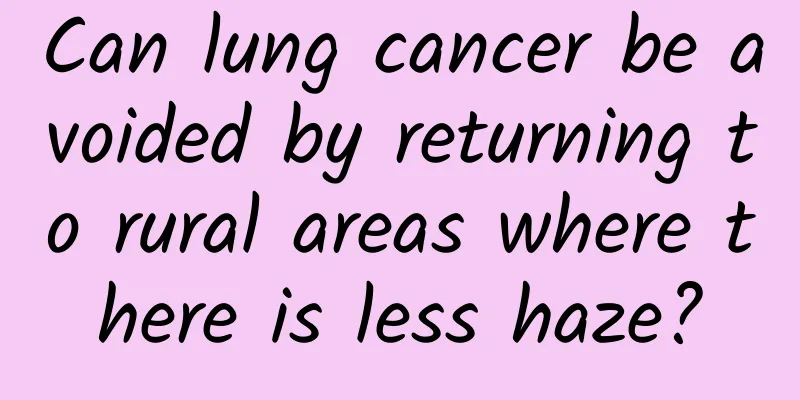Can lung cancer be avoided by returning to rural areas where there is less haze?

|
What we are avoiding is not only the smog, but also our health. With the improvement of living standards, the cost of living in big cities is getting higher and higher, and what accompanies us is the smog and exhaust gas that are constantly absorbed by us. Then these pollutions become one of the carcinogenic factors. Air pollution, genetics, bad living habits and other factors together constitute lung cancer, becoming the "number one killer" among cancers. There are many factors that cause cancer, and environmental pollution is one of the important factors. So if I go back to the countryside, will I not have the risk of lung cancer? In fact, this is not the case. Here I want to share with you some popular science. Cancer is not caused by one disease, but a combination of multiple diseases. Types of lung cancer The classification of lung cancer is also commonly called pathological information. Based on the morphological characteristics of lung cancer cells under a microscope, the pathological classification of lung cancer is divided into two types: small cell lung cancer (SCLC) and non-small cell lung cancer (NSCLC). The growth characteristics, spread risks and treatment plans of these two types of lung cancer are different, so they must be distinguished first. In clinical practice, non-small cell lung cancer is divided into lung adenocarcinoma, squamous cell carcinoma (squamous cell carcinoma), large cell carcinoma, and adenosquamous carcinoma. Small cell carcinoma is less common in clinical practice, accounting for about 20%, which means that about 1 in 8 lung cancer patients has small cell carcinoma. For non-small cell lung cancer, 80% of lung cancer patients have non-small cell lung cancer. When patients are diagnosed, they are already in the middle and late stages, and the 5-year survival rate is very low. This cancer grows and spreads more slowly than small cell lung cancer, and the treatment method is also different. At present, innovative immunotherapy drugs are recommended as first-line and second-line treatments for non-small cell lung cancer (NSCLC), including PD-1 inhibitors carrelizumab and pembrolizumab, and PD-L1 inhibitors durvalumab and atezolizumab. Fortunately, advanced non-small cell lung cancer has been a hot area for the development of new anti-tumor drugs in recent years, with many innovative drugs and a number of immunotherapies approved for marketing. For the treatment of non-small cell lung cancer, in addition to the three major treatment methods of surgery, radiotherapy and chemotherapy, the era of targeted therapy and immunotherapy has also arrived. The above figure shows the survival curves of different genders + diagnosis ages for patients who have just been diagnosed with lung and bronchial cancer. For patients with lung and bronchial cancer, it is important to know whether they are in the early-onset, high-incidence, or late-onset group of lung and bronchial cancer, because the age of onset is often the main factor in comprehensive consideration of tumor staging, differentiation, surgical or radiotherapy radical resection, drug efficacy, recurrence, and prognosis. The survival curve refers to a curve drawn according to different genders and diagnosis ages, with the patient's survival time (unit: month) after cancer diagnosis as the horizontal axis and the logarithm of the number of surviving patients as the vertical axis. It reflects the probability of cancer patients surviving at different times due to different genders and diagnosis ages. The survival curve in the figure above is calculated using the most commonly used KM algorithm. Generally speaking, a high curve with a gentle decline indicates a high survival rate or a longer survival period; a low curve with a steep decline indicates a low survival rate or a shorter survival period. How to prevent lung cancer in daily life? 1. Eat less fried, smoked and grilled foods Eating too much of this kind of food can easily cause cancer, including lung cancer. These cooking methods make the food lose its original nutritional value and produce many harmful substances. For example, after being fried at high temperatures, proteins and some amino acids can produce substances that are 100 times more carcinogenic than benzodiazepines. These foods contain "acrylamide", which is 10 times more carcinogenic than "cigarettes". 2. Eat more fruits and vegetables and drink less alcohol Eating more vegetables and fruits rich in vitamins can help prevent the harm of oxygen free radicals to the human body and play an important role in preventing some chronic diseases, especially heart disease and cancer. In addition, when it comes to daily lung care, you can pay more attention to traditional Chinese medicine. You can take some Chinese medicine for clearing the lungs and relieving coughs on a daily basis to consolidate lung qi and enhance the body's immunity. 3. Ban or control smoking Foreign studies have proven that quitting smoking can significantly reduce the incidence of lung cancer, and the earlier you quit smoking, the more significant the reduction in lung cancer incidence. Therefore, quitting smoking is the most effective way to prevent lung cancer. 4. Improve the indoor environment Existing studies have shown that exposure doses of air pollution, deposition index, smog index, benzopyrene, etc. are positively correlated with the incidence of lung cancer. Improving the indoor environment and reducing air pollution are important measures to reduce the incidence of lung cancer. 5. Prevention of occupational factors It is generally recognized that many occupational carcinogens increase the incidence of lung cancer, and reducing exposure to occupational carcinogens can reduce the incidence of lung cancer. "Returning to the countryside" is not a good way to avoid lung cancer. Paying attention to food safety, changing bad living habits, and regularly undergoing CT scans can help prevent the occurrence of lung cancer. Through precision medicine and scientific drug rotation, patients will achieve a high-quality life with tumors. I hope that while everyone is accepting the pressure brought by life, they can also stop and travel with their heart. |
>>: Healthy Life Oil | What is margarine?
Recommend
What is the best medicine for pelvic inflammatory disease?
Everyone should know that the female urinary syst...
Psychological weaknesses of 40-year-old women
People at every stage have certain psychological ...
How much blood does my aunt bleed during her period?
Women have to deal with menstruation for most of ...
【Health Science】Don’t touch! Don’t eat! Urgent reminder
March It’s spring and flowers are blooming When e...
Ding Dong! Keep this eye protection guide after the holidays to help you keep your eyes bright all year round
Although the Spring Festival holiday has ended, t...
Frequent coughing and chest tightness? Beware of this "fatal suffocation"
In early winter, Chengdu was hit by a sudden drop...
TCT atypical squamous cells cannot be clearly defined
If you feel any discomfort in your body, it means...
How to make pork and mushroom dumpling filling tender? How to mix dumpling filling?
Dumplings are a very popular delicacy. Everyone m...
The difference between prebiotics and probiotics
Yisheng Alkali is the flagship brand of Guangzhou...
What causes endometritis bleeding?
What causes endometritis bleeding? Endometritis b...
Will eating in the cafeteria spread the new coronavirus? How to protect yourself when eating in the company cafeteria during the epidemic?
We all know that the new coronavirus is a relativ...
"Child's" heart and "vision": the process of children's visual development
Author: Hao Rui, deputy chief physician of Tianji...
Can fallopian tube inflammation be detected by ultrasound?
If you can't get pregnant for a long time, wo...
What to do if female follicles are not developing well
In order to complete the process of pregnancy, yo...
What's the matter with less traffic?
Menstruation is a physiological phenomenon that e...









